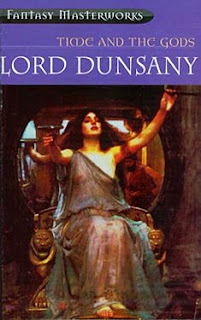Time and the Gods consists of six volumes: Time and the Gods (1906), The Sword of Welleran and Other Stories (1908), A Dreamer's Tales (1910), The Book of Wonder (1912), The Last Book of Wonder (1916), and The Gods of Pegana (1905). In each of these volumes, Dunsany weaves tales of beauty, caprice, and discovery. The first part of this collection, Time and the Gods, is perhaps representative in tone for these six volumes. Over the course of twenty related short stories, Dunsany traces the relationship between the gods (retreading with certain changes the ground trod in The Gods of Pegana) and their slave Time, who dreams of overthrowing and devouring the gods just as he has been given license to do to the gods' creation, the world.
Some of the best mythopoeic literature approaches poetry and each of these stories is infused with poetic cant. Read aloud this passage that opens the first tale, "Time and the Gods":
Once when the gods were young and only Their swarthy servant Time was without age, the gods lay sleeping by a broad river upon earth. There in a valley that from all the earth the gods had set apart for Their repose the gods dreamed marble dreams. And with domes and pinnacles the dreams arose and stood up proudly between the river and the sky, all shimmering white to the morning. In the city's midst the gleaming marble of a thousand steps climbed to the citadel where arose four pinnacles beckoning to heaven, and midmost between the pinnacles there stood the dome, vast, as the gods had dreamed it. All around, terrace by terrace, there went marble lawns well guarded by onyx lions and carved with effigies of all the gods striding amid the symbols of the worlds. With a sound like tinkling bells, far off in a land of shepherds hidden by some hill, the waters of many fountains turned again home. (p. 3)
Dunsany employs a very florid style here, one that perhaps might get the unwary writer in trouble were she to attempt aping this style without paying close attention to how Dunsany utilizes imagery. Within the lush descriptions lies a directness, as may be found in this telling passage from later on in the first volume:
And a gentle rain came falling out of heaven and stilled the restless sand, and a soft green moss grew suddenly and covered the bones till they looked like strange green hills, and I heard a cry and awoke and found that I had dreamed, and looking out of my house into the street I found that a flash of lightning had killed a child. Then I knew that the gods still lived. (p. 89)
Poetic prose coupled with sardonic commentary. That perhaps is a fitting one sentence description of this first volume. In the following volumes, there is not quite the biting commentary of the first, but there are still stories that combine descriptions of beauty with a sense of impermanence. One such example may be found in "The Fall of Babbulkund," found in the second volume, The Sword of Welleran and Other Stories:
Now this is the dream that King Nehemoth dreamed on the first night of his dreaming. He saw move through the stillness a bird all black, and beneath the beatings of his wings Babbulkund gloomed and darkened; and after him flew a bird all white, beneath the beatings of whose wings Babbulkund gleamed and shone; and there flew by four more birds alternately black and white. And, as the black ones passed Babbulkund darkened, and when the white ones appeared her streets and houses shone. But after the sixth bird there came no more and Babbulkund vanished from her place, and there was only the empty desert where she had stood, and the rivers Oonrana and Plegáthanees mourning alone. (p. 156)
This dreamlike quality, which creates settings that are ephemeral and shimmer like gossamer, allows Dunsany to craft short fictions of fifteen pages or less that are vivid and memorable as if he spent much more time developing the settings. Yet despite the florid prose he often employed (apparently learned from his school-age forced studies of the King James Bible), Dunsany displays an ability to develop his settings with just a single paragraph or two; something that several writers ought to learn how to master when trying to place stories in constructed settings. But beyond these memorable settings are characters who tend to be somewhat out of place. This sense of disconnection accentuates the otherworldliness of the settings and this strangeness adds to the unfolding stories, whose plots are generally very simple in their execution. Yet because Dunsany utilizes language and setting so expertly, these plots, with their relatively plain progressions, complement the prose nicely, thus creating stories that are a pleasure to read, as the reader can get "lost" in the words and not in trying to decipher the plot.
There are very few "off" stories in this collection. Dunsany crafted tales that remind the reader of some of the best vignettes of William Blake. If anything, Dunsany perhaps is a perfect example of how the Romantics and their visions of Beauty and Ruin influenced the fantasists of the late 19th and early 20th century, such as George MacDonald and William Morris, who in turn influenced later writers such as E.R. Eddison, C.S. Lewis, and J.R.R. Tolkien. His fictions, as well as his dramas and poems, have influenced so many of the writers who influenced more "modern" fantasists, that it is a shame that his works, "Masterworks" nearly one and all, have so often gone out of print since his death in 1957. Dunsany's writings are so poetic and yet so direct in their communication of ideas and emotions that they will doubtless bring pleasure to most readers who decide to read them as a pleasant diversion.


No comments:
Post a Comment